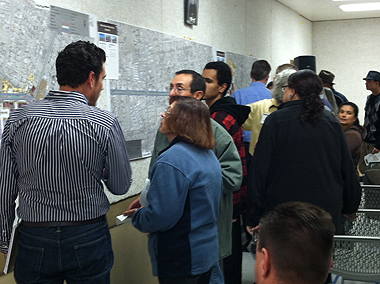
IN THIS ISSUE:
Grantee Spotlight: Albuquerque’s Bridge Boulevard Redevelopment Plan
Mixed-Use, Mixed-Income Development near Rail Transit in Reading, Massachusetts
ARRA-Funded Energy-Efficiency Program Seeds Private-Sector Financing
Earn-A-Bike Aims to Get the University of Louisville Cycling
Grantee Spotlight: Albuquerque’s Bridge Boulevard Redevelopment Plan

Residents and business people discuss planning issues at a public meeting on December 5, 2012. Image courtesy of Bernalillo County Public Works Division.Bridge Boulevard carries more than 30,000 cars a day across the Rio Grande River and through the center of the South Valley near Albuquerque, New Mexico. In response to concerns about safety, congestion, business revitalization, and housing affordability in the corridor, Bernalillo County initiated the Bridge Boulevard Corridor Redevelopment Plan process in 2011. The county is investing $382,188 to augment $500,000 in joint HUD Community Challenge Planning Grant and U.S. Department of Transportation (DOT) Tiger II Planning Grant funding, which is being used to prepare a plan that supports mixed-use development, including affordable housing, and to improve transportation options. The planning process has included extensive community involvement, and the county planning commission will review the plan before the county board of commissioners considers it for adoption in spring 2013.
Planning to Revitalize Bridge Boulevard
The draft Bridge Boulevard Corridor Redevelopment Plan provides guidance for the rejuvenation of a 3-mile segment of Bridge Boulevard at the western approach to the Barelas Bridge near downtown Albuquerque. The historic South Valley is an economically distressed part of the county, where a lack of transportation choices has proven particularly burdensome to low-income residents, seniors, and disabled individuals. New Mexico has one of the highest pedestrian and bicyclist fatality rates in the nation, and barriers to economic competitiveness include a dearth of major employers and retail establishments in the South Valley. The plan suggests improvements to the public street, which is saddled with severe automobile congestion and limited access for pedestrians and buses. The plan also addresses the future use of properties within the corridor currently occupied by struggling local businesses, residences, and small farms.
Improving Transportation and Land Use
The county has worked hard to develop consensus for its redevelopment plan, which takes into account the needs of its diverse population and honors the area’s historic and agricultural legacy. Its large Hispanic population, for example, includes both long-time residents and more recent Latin American immigrants, whose unique cultural backgrounds and traditions continue to shape the community as a whole.
Based on community preferences expressed at public meetings, the draft redevelopment plan redesigns Bridge Boulevard as a main street accommodating pedestrians, bicycles, and buses while improving automobile traffic flow and safety. The main street design provides for a 6- to 12-foot-wide sidewalk, a bike lane, and two car lanes in each direction. The outer lanes are designated for buses and high-occupancy vehicles during peak hours. A 14-foot-wide median separates the directional flows, and a parking lane is provided on one side of the street. More frequent bus service and improved traffic flow with traffic circles and coordinated signals, as well as upgraded pedestrian signals, continuous sidewalks, lighting, and landscaping, are also proposed.

The draft Bridge Boulevard Corridor Redevelopment Plan proposes three mixed-use hubs along the 3-mile corridor west of Barelas Bridge. Source: Bernalillo County, draft of Bridge Boulevard Corridor Redevelopment Plan, January 2013.
Another objective is to revitalize business and ensure housing affordability through the development of three mixed-use hubs along the corridor, each with a different economic focus. The Gateway District at the corridor’s eastern end will serve as the portal for tourists to the rest of the corridor and the South Valley. At the same time, the district will encourage the development of residences adjacent to Gateway Park, with its existing amphitheater and proposed farmer’s market. The Tower Employment District at the boulevard’s western end will become an employment center featuring large-scale office, warehouse, and light industrial uses, as well as residences and retail stores. Between those two hubs, the Five Points Village Center will be a local business center with a grocery, pharmacy, and other stores to meet the daily needs of the corridor’s residents. The draft plan’s proposal for higher density housing, including affordable housing, in all three hubs has yet to be generally accepted by many corridor residents, who see three-story suburban housing as out of character with their semirural community, according to Richard Meadows, transportation planner in the Bernalillo public works division and manager of the redevelopment planning process.
Finally, the draft plan includes a set of proposed zoning regulations for the mixed-use hubs and the properties between them. The plan suggests design guidelines and procedures that facilitate the review of development applications. Possible funding sources for the public improvements and affordable housing include federal low-income housing tax credits and a locally created metropolitan redevelopment area. The latter would allow the county to use property tax deferrals or waivers, property-tax-increment financing, or revenue bonds for projects that address blight or promote business development in the Bridge Boulevard corridor.
The draft redevelopment plan encourages mixed-use development and improved transportation along the corridor. The generally positive public response to the redevelopment efforts thus far suggests an appreciation for both the opportunities for active community involvement in the process (including a three-day planning charrette, two special public meetings, surveys, and focus groups) and the draft plan’s thoughtful balance of roadway demands and human livability factors. Meadows emphasizes the community’s support for what the plan seeks to accomplish: “People want to revitalize the corridor with local neighborhood businesses they can walk to. They also want employment nearby, improved transit, and improved safety.”
